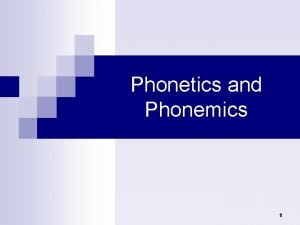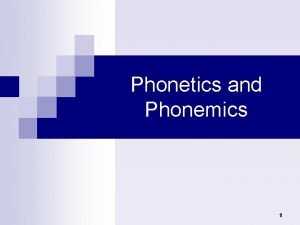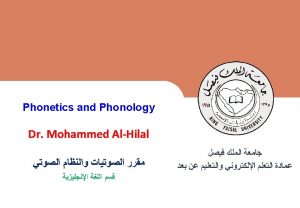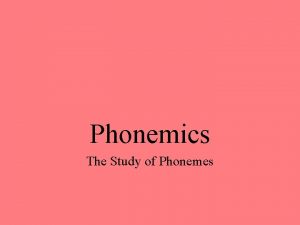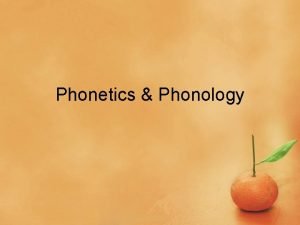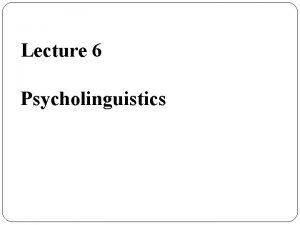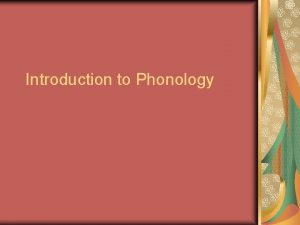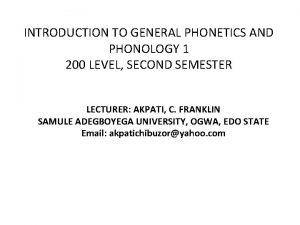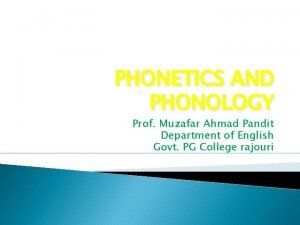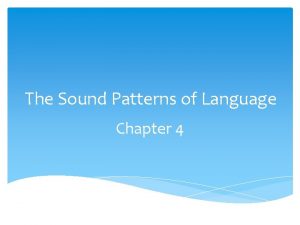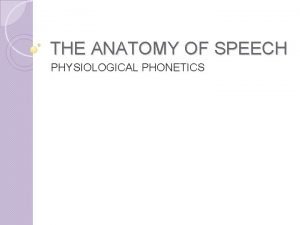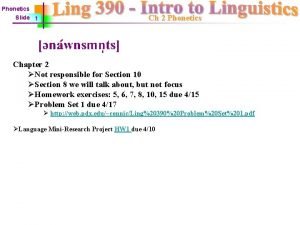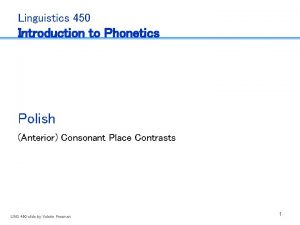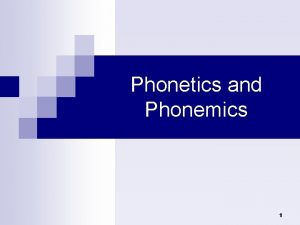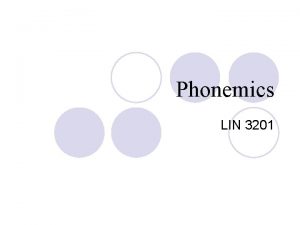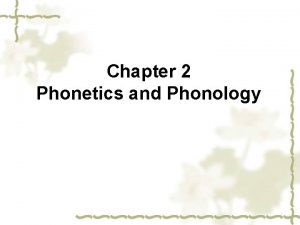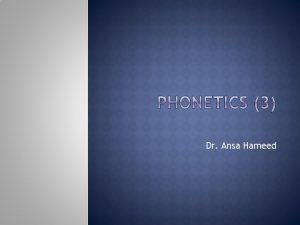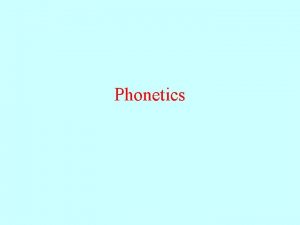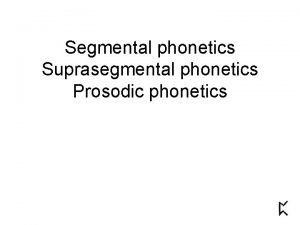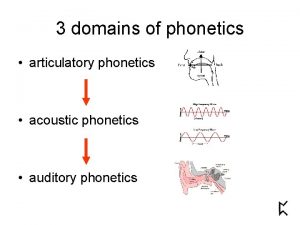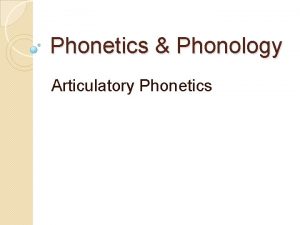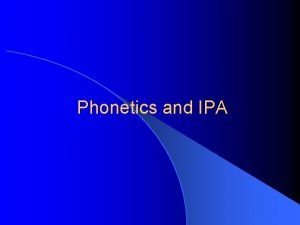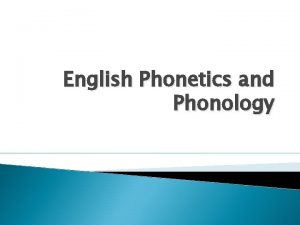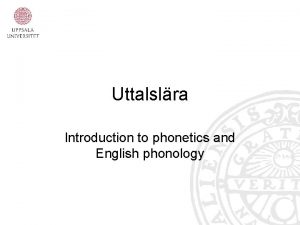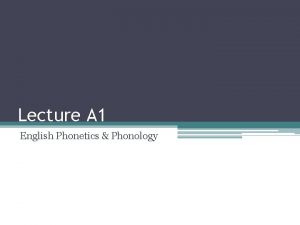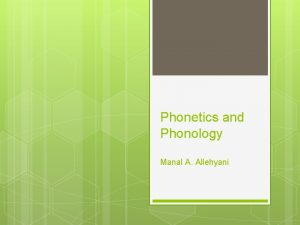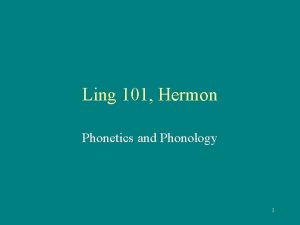Phonetics and Phonemics 1 Phonetics and Phonemics n






















- Slides: 22

Phonetics and Phonemics 1

Phonetics and Phonemics: n The principle goal of Phonetics is to provide an exact description of every known speech sound n Domain of phonetics is independent of any particular language n Phonemics is used for the study of speech sounds as they are perceived of by speakers of particular language 2

Phonetics: n Articulatory phonetics ¨ How any given speech sound is produced, with particular emphasis on anatomical detail n Acoustical phonetics ¨ The emphasis is on observable, measurable characteristics in the waveform of speech sounds ¨ Provides theoretical and experimental background for speech recognition and synthesis by electronic hardware 3

Articulatory phonetics : n The first task of articulatory phonetics is to describe speech sound in the terms of position of the vocal organs n Phonetic alphabet ¨ Phoneticians have had to devise their own system of notation n IPA n ARPAbet 4

Excitation Of The Speech System Phonation n Whispering n Frication n Compression n Vibration n 5

Articulatory phonetics n (consonants) : Categories ¨ Consonants: easy to define in anatomical terms n Point of articulation: this I the location of the principal constriction in the vocal tract ¨ ¨ ¨ Bilabial Labiodental Apicogingival Apicoalveolar Apicodomal Laminoalveolar Laminodomal Centrodomal Dorsovelar Pharyngeal Glottal 6

…Consonants: n Manner of articulation: the degree constriction at the point of articulation and the manner of release into the following sound Plosive ¨ Aspirated ¨ Affricative ¨ Fricative ¨ Lateral ¨ Semivowel ¨ Nasal ¨ Trill ¨ 7

…Consonants: n Voicing: this indicates the presence or absence of phonation Voiced ¨ Unvoiced ¨ 8

Articulatory phonetics (vowels) : ¨ Vowels: vowels are much less well defined than consonants, this because tongue typically never touches another organ and vowels described by Tongue high or low n Tongue front or back n Lips rounded or unrounded n Nasalized or unnasalized n n Diphthongs: combined two vowel sound in a single syllable by moving tongue from one position to another 9

Articulatory phonetics : ¨Diphthongs: combined two vowel sound in a single syllable by moving tongue from one position to another ¨Coarticulation: n No speech sound is produced accurately in the context of other sound n Overlapping of phonetic features from phone to phone is termed coarticulation 10

Phonemics: n Phonetics is a view of speech sounds considered in isolation from any languages n Phonemics is the view from within some specific language n Phonemes ¨ In phonetics, an individual sound is a phone ¨ In phonemics, the smallest unit is the phoneme 11

Phonemics (phonemes): n A phoneme is the smallest sound unit in a given language that is sufficient to differentiate one word from another n Example: ¨ In English, Voicing is a feature which distinguishes between two phonemes n ‘bug’ contrast with ‘buck’ ¨ In some contexts voicing is not phonemics in German n ‘Tag’ can be pronounced either [ta: g] or [ta: k] 12

13

14

Phonemics (phonemes): n The largest number of phoneme known is 45 in Chipewyan, the smallest is 13 in Hawaiian n English has 31 to 64 and Persian has 29 to 45 phonemes, depending on how they are analyzed 15

Phonemics (Allophones): n A phoneme is actually a set of phonetically similar sound which are accepted by the speakers of the language as being the same sound. Members of the set are called allophones. n Example: ¨ The /k/ in “kin” and “cup”. ¨ The /k/ in “cope” and “scope”. 16

English Phonemes uw ux uh ah ax ah-h aa ao ae eh ih ix ey iy ay ow aw oy er axr el Semi-vowels y r l el w Vowels Fricatives jh ch s sh z zh f th v dh Nasals m n ng em en eng nx Stops b d g p t k dx q bcl dcl gcl pcl tcl kcl hv hh Aspiration 17



20

21

22
 Phonetics and phonemics
Phonetics and phonemics Phonetics and phonemics
Phonetics and phonemics What is the difference between phonetics and phonology
What is the difference between phonetics and phonology Phonemics meaning
Phonemics meaning Allophone
Allophone Differences between phonetics and phonology
Differences between phonetics and phonology What are minimal pairs in linguistics
What are minimal pairs in linguistics Phonetics and phonology
Phonetics and phonology Rowe concise introduction to linguistics download
Rowe concise introduction to linguistics download Drc model of reading
Drc model of reading Difference between phonetics and phonology
Difference between phonetics and phonology Introduction to general phonetics and phonology
Introduction to general phonetics and phonology Secondary vowels
Secondary vowels Phonetics and phonology
Phonetics and phonology What are sound patterns that have meaning
What are sound patterns that have meaning Liaison in phonetics
Liaison in phonetics Phonetic anatomy
Phonetic anatomy Triphthong smoothing
Triphthong smoothing What are minimal pairs examples
What are minimal pairs examples Natural classes phonology
Natural classes phonology Articulatory organs
Articulatory organs 2 phonetics
2 phonetics Anterior consonants
Anterior consonants
